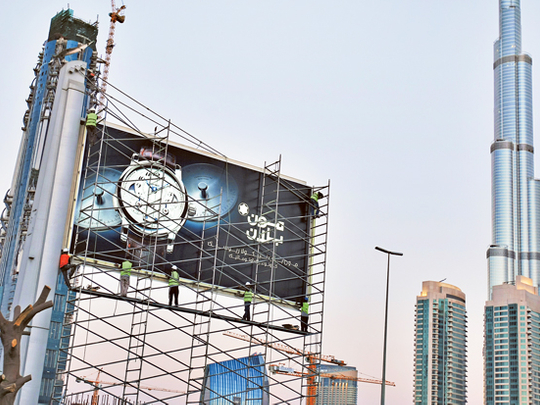
Digital signage should be considered as a chameleon. It’s format and purpose varies across verticals and countries, occupying significant space on American freeways and noticeable nooks in European boulevards.
When it comes to the UAE, a deep understanding of the region, Dubai in particular, is required for digital signage solutions to change their colours. Out-of-home is plentiful, especially in Dubai where large format signs spanning blocks and storeys are used to hide construction sites from passing traffic. In stark contrast to the old, Dubai is all about the new, the first, the biggest.
Enter digital out-of-home.
Many of the buildings in Dubai are recent constructions or currently being completed, allowing digital signage to be incorporated into blueprints versus added as an afterthought. By including screens in the original architecture, deployments exude intention and are aesthetically pleasing — a perfect easel for advertising.
JCDecaux Dicon’s screens in Dubai International Airport attest to this, as do the two-panel, two-sided kiosks and LED screens situated throughout The Dubai Mall.
To bring more attention to the space, SGI Dubai began to court digital signage exhibitors in 2014 and continued to do so this year. Unlike other print shows with a similar mindset, SGI Dubai did not bring these vendors together in a dedicated space on the show floor, nor was there a conference line up to educate printers interested in digital.
Indeed, more digital signage could be found outside of the halls than within, despite the 400 exhibitors from 34 countries and 12,000 visitors from 78 countries expected to attend.
This trade show aside, convention centers and event locales are prime venues for investment in digital signage. Global events like the Olympics and FIFA World Cup have triggered increased advertising spend and digital signage deployments, most recently in the United Kingdom and Brazil. Sure to raise demand for DOOH is the World Expo 2020 in Dubai, the FIFA World Cup hosted by Qatar in 2022 and when the Formula 1 Grand Prix revs up in Abu Dhabi each year.
Indeed, premium out-of-home advertising locations in Dubai are as valuable as those in high density, world famous spots in the US, at least in terms of ad dollars. In December 2012, the Wall Street Journal reported on the annual rents of digital billboards at One Times Square, ranging from $1.1 million to $4 million (Dh4 million to Dh14.7 million) depending on the size and placement of the screen.
It is highly likely that these costs have increased since then and important to note that they do not include the expensive aspect of content creation.
A similar billboard on Shaikh Zayed Road in Dubai might go for $1.2 million (Dh4.4 million) per year. The fact that out-of-home advertising in Dubai demands similar advertising dollars as in New York is a good “sign”, illustrating the progressive nature of the Dubai market and coveted audience it promises.
What next? According to a Tech-Sci Research report, digital signage in the UAE is projected to grow at a CAGR (compounded annual growth rate) of 23 per cent between 2014 and 2019. An IHS Technology Report from February 2014 predicted that by the end of 2017, digital signage shipments in MEA (Middle East and Africa) will be up 61 per cent from 2012 levels compared to a 3 per cent and 4 per cent increase in Eastern and Western Europe, respectively.
Such a land of sand, sun and screens makes for an interesting DOOH market, with attributes (and true colours) that differ from the rest of the world.
The writer is the Marketing and Business Development Manager at BroadSign International.











